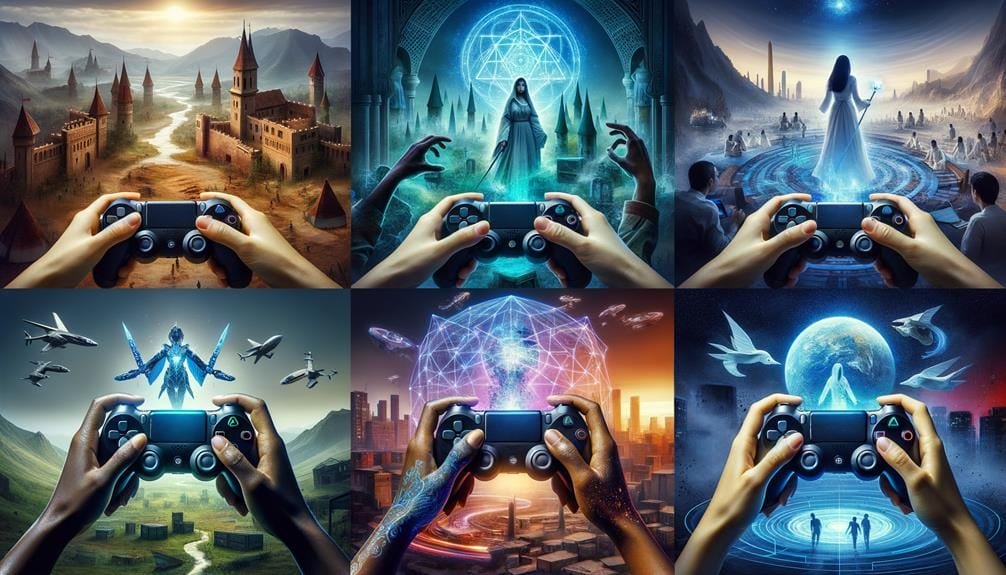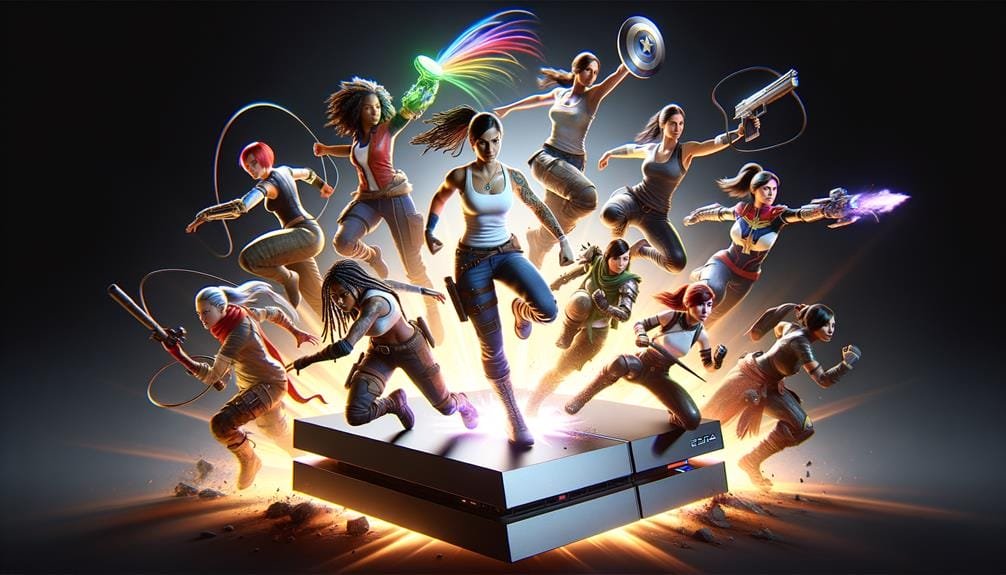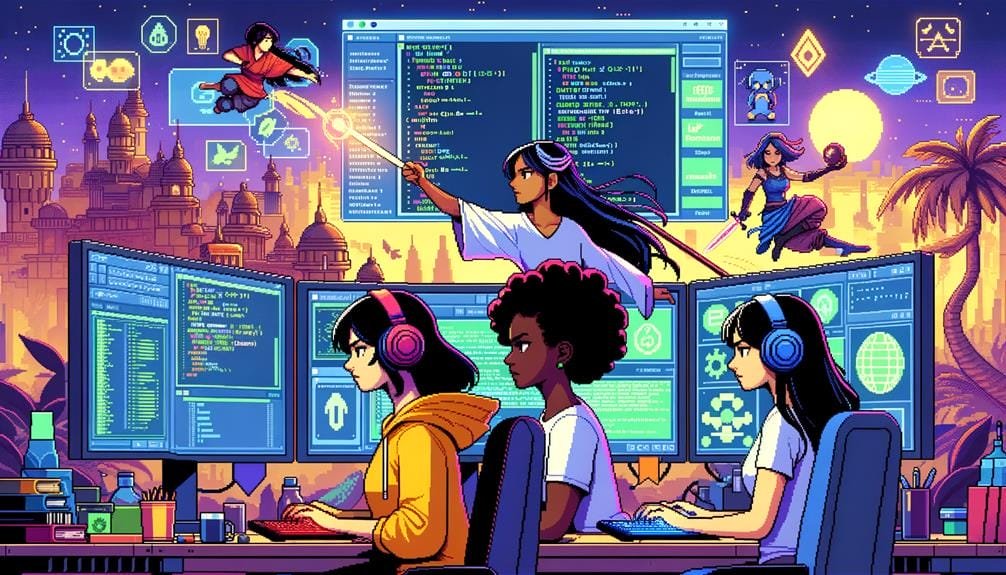Our Newsletter
Sign up for our e-mail newsletter and stay informed for what’s next on the horizon.
Some might suggest that the gaming industry is primarily male-centric, yet it’s impossible to overlook the substantial contribution women have made, and continue to make, in molding this energetic sector.
Ranging from the development of innovative games to spearheading prominent companies, women consistently challenge limits and redefine the gaming arena.
Interested in learning more about the women who’ve courageously disrupted the norm and their influence on the gaming world? Stay tuned, as we journey through this exciting adventure, and you may just reveal a new outlook on the gaming world.
Peering into the future landscape of gaming, it’s challenging not to be brimming with expectation. Women are not just actively involved; they’re revolutionizing the sphere, shaping it, steering it.
From the crafting of game narratives to their role in esports, their sway is undeniable and growing. This challenge is thrilling, yet it’s far from being fully realized. Our duty? To continue championing, backing, and endorsing equality in this industry.
The forthcoming era of gaming? It’s led by women.
Throughout the years, women like Carol Shaw, Dona Bailey, Roberta Williams, Kim Swift, Anna Anthropy, and Auriea Harvey have played a significant role in the transformation of the gaming industry, challenging stereotypes and extending the boundaries of game development. Starting from the 1970s and 1980s, Shaw and Bailey laid the groundwork, developing digital games for Atari. Swift carried on, displaying women’s skills as she took the reins in designing Portal.
Williams shattered obstacles with Kings Quest in 1984, an instrumental moment that ignited a significant change in game design. This progress can be likened to the advancement of popular games like Assassins Creed and the Uncharted series, which consistently adapted to meet the changing preferences of players. Anthropy and Harvey showcased women’s distinct viewpoints in game design, with the making of dys4ia and the shared creation of Luxuria Superbia respectively.
The gaming industry has undergone a significant transformation, and women have been driving this change. They’ve not only contested stereotypes but also influenced the progression of games, leaving their imprint in this dynamic industry. Their contributions have made a difference, creating opportunities for future generations of female game developers and players who seek liberty in the gaming universe.
Examining the achievements of pioneering female game developers, we find innovators such as Carol Shaw, Dona Bailey, Roberta Williams, Kim Swift, and Anna Anthropy, who’ve significantly molded the gaming industry with their inventive creations and deep narratives. These women not only shattered barriers but also enriched the industry with their unique viewpoints, thus advocating for diversity.
In addition, Kim Swift’s Portal and Anna Anthropy’s dys4ia are proof of women’s capability to craft inventive and affecting narratives. Their work continues to inspire a new generation of female game developers, confirming that gender doesn’t restrict creativity or skill. As we continue our exciting journey, we’ll study more ways women have influenced and continue to reshape gaming.

Transitioning our attention to the domain of esports, we observe that women make up about 30% of the viewership, emphasizing their considerable interest and participation in competitive gaming. Their influence is noticeable not just among the spectators but also within the games. Women have achieved impressive victories in video games like Counter-Strike: Global Offensive, League of Legends, and Overwatch.
| Esports Games | Noteworthy Women Players |
|---|---|
| Counter-Strike: Global Offensive | Women have overcome obstacles |
| League of Legends | Women have attained triumph |
| Overwatch | Women are reshaping the gaming scene |
However, the journey towards equal representation in esports is still ongoing. The pay disparity continues to exist, with male players often receiving significantly more than their female counterparts in tournament winnings and sponsorships. To combat this, organizations like Intel Extreme Masters and ESL One are launching programs to encourage inclusion and diversity.
Women-centered esports leagues such as the Women’s Esports League (WEL) offer platforms for women to compete, connect, and demonstrate their abilities. These efforts underscore the proactive role of women in molding the future of esports, challenging stereotypes, and advocating for a more inclusive gaming environment.
Encouraging gender balance in gaming is a crucial issue that demands our attention as we advance.
Breaking down cliches and fortifying female gamers are essential measures towards realizing this aim.
We should examine how these initiatives can impact the gaming sector and foster a more welcoming atmosphere.
In the context of a scant 24% representation in game creation, it’s evident we need to confront and overhaul gender stereotypes in the gaming industry. The enduring gender bias in this sector not only reduces opportunities for women but also hampers the variety and originality of video games, affecting their attractiveness to a broader audience.
To shatter these stereotypes, we suggest the following measures:
While strides are being made to break down gender stereotypes in game development, it’s just as vital to uplift the female gamers who make up 41% of the gaming community and greatly add to the industry. In the realm of video gaming, they often experience discrimination and harassment, highlighting an immediate need for a shift.
Representation is important, and it’s overdue for the video game industry to present more diverse, empowering depictions of women. Achievements like that of Amy Hennig, a pioneer in game design, show that inclusive games connect with a broad audience, gaining both commercial and critical praise.

In the domain of video game stories, women are making considerable progress. They’re not only contesting conventional typecasts, but also pioneering game creation and redefining the roles of female characters.
These changes toward diversity and inclusivity are reforming the gaming environment and providing empowering stories for players to interact with.
Busting traditional norms, females in the gaming sector are innovating game narratives by bringing in diverse storytelling approaches and viewpoints that counter classical stereotypes. They’re not only altering characters; they’re reshaping the entire narrative terrain.
Women are shaping characters with substance and control, disputing the usual depiction of women as mere supporting roles or helpless damsels.
They’re managing and crafting games that connect with a wider audience, using distinctive narrative elements to offer novel experiences.
Their contributions are resulting in more comprehensive representation within game narratives, endorsing diversity and genuineness.
Game development led by women is swiftly altering the world of gaming, infusing it with original viewpoints, inventive narratives, and varied characters. These creators have produced not only critically praised and commercially profitable games, but have also introduced distinct gameplay techniques that are altering the nature of games. In the process, they’re fostering a more inclusive gaming atmosphere that appeals to a broader audience.
It’s not solely about producing games; it’s about contesting stereotypes, pushing the limits, and providing new, inventive experiences. Their endeavors are causing a wave of change in the industry, ensuring that the gaming world is a space where everyone can find a narrative that speaks to them. This progression, propelled by women, is an exciting journey toward a more diverse and inclusive gaming environment.
Surveying the changing terrain of gaming, it’s clear that female characters are advancing from the sidelines to assume more varied and intricate roles in game narratives. The era of damsels in distress is over.
These progressing roles provide not only liberty for creators but also for the players, setting the stage for a more inclusive gaming universe.

Venturing into the world of video games, we encounter several remarkable female characters who’ve made a significant impression on players worldwide. Lara Croft, the iconic explorer from Tomb Raider, pioneered with her problem-solving skills and unyielding spirit. She’s a symbol of female empowerment, adeptly traversing dangerous tombs and surviving against all odds.
In the post-apocalyptic environment of Horizon Zero Dawn, we encounter Aloy, a clever heroine who fights robotic creatures with inventiveness and bravery. Her strong, independent character resonates with players looking for characters with depth and durability.
The Last of Us presents us with Ellie, a multifaceted character whose progression forms the emotional essence of the game. She’s more than just a survivor; she’s a testament to the human spirit in a world turned chaotic.
Bayonetta, the fashionable witch from her self-named series, and Chell, the quiet test subject in Portal, each offer distinctive gameplay experiences. Bayonetta’s extravagant battles and Chell’s complex problem-solving highlight the variety of roles that female characters can occupy, further solidifying their significance in the gaming world.
Let’s shift our focus to the pioneering women in game design who are breaking down stereotypes. Overcoming the hurdles of the industry, these women aren’t only prospering but also making a significant impression.
They’re molding the gaming future, introducing new viewpoints and fostering variety in the gaming universe, all while dealing with gender-related impediments.
Defying norms and laying the groundwork for upcoming generations, leading female game designers such as Carol Shaw, Dona Bailey, Roberta Williams, Kim Swift, and Anna Anthropys have significantly influenced the gaming industry. Their innovative additions haven’t only displayed their creative abilities but also their persistence in a predominantly male industry.
These women are genuine trailblazers, their work motivating a multitude of others to pursue their path.
Despite significant progress made by trailblazing women in game design, gender biases and stereotypes continue to exist, often constraining opportunities and representation for women in the gaming industry. Only 24% of game developers are women, yet they contribute varied perspectives and creativity that enrich storytelling and gameplay experiences. Games that include diverse characters and narratives, often created by women, draw broader audiences and boost industry revenue. Games produced by women have demonstrated success both in terms of sales and critical acclaim, contesting stereotypes and setting the stage for more female representation in game development.
Here’s a brief summary:
| Challenges | Benefits | Impact |
|---|---|---|
| Gender biases | Varied perspectives | More diverse games |
| Constrained opportunities | Amplified creativity | Increased industry revenue |
| Enduring stereotypes | Sales success | Shifting viewpoints |
Women in the gaming industry have made noteworthy advancements, breaking down stereotypes through unparalleled storytelling and inventive gameplay experiences. Their work has led to:
The impact and influence of women in game design shouldn’t be undervalued. Their input is genuinely transformative.
Within the domain of game development, an increasing count of women-led firms are defining their own territory, infusing new, varied viewpoints and creativity into the sector. The emergence of these firms signifies a shift toward greater inclusivity and diversity in a traditionally male-centric field.
These vibrant firms, led by female entrepreneurs, aren’t merely crafting innovative and distinct gaming experiences, but also reshaping the industry’s panorama. They’ve produced successful and critically praised games, illustrating the capability and foresight that female developers contribute.
More significantly, these women-led game development firms aren’t just adding to the industry; they’re playing an essential role in motivating and empowering other women. They’re exemplifying that women too can be pioneers in game development, dismantling obstacles and questioning stereotypes.
In the end, the rise of women-led game development firms is providing immense benefits to the gaming world. By encouraging inclusivity and diversity, they’re enhancing the gaming environment and crafting superior experiences for all players. We’re observing an exciting journey, indeed, as these firms persist in altering the gaming world.

Focusing on the indie game sector, we observe women making substantial impacts, breaking barriers, and offering new, distinctive viewpoints in gaming. This vibrant and adaptable part of the industry provides a stage for women to display their creativity, contest stereotypes, and bring new ideas.
The indie game sector isn’t merely a subset within the gaming industry; it’s a hotbed of innovation and creativity. And it’s in this space that women are making a significant and lasting impact, transforming the gaming landscape.
As we appreciate the progress women are achieving in the indie gaming sector, it’s inspiring to anticipate what the future might hold for women in the wider gaming industry. Increasing recognition and support for gender diversity are setting the stage for enhanced opportunities. More women are entering STEM fields related to game creation, indicating a rise in female involvement.
In the realm of esports, the scope for women is broadening. This is a substantial step forward, facilitating competitive participation and career development for numerous female gamers. Sustained efforts to counter sexism and prejudice are making the gaming industry more welcoming. It’s a battle that must persist, but it’s encouraging to witness improvement.
Looking towards the future horizon of gaming, it’s hard not to be filled with anticipation. Women aren’t merely participating in the game; they’re transforming it, constructing it, directing it.
From game narratives to esports, their influence is indisputable and expanding. This endeavor is exhilarating, but it’s far from complete. Our responsibility? To persist in advocating, supporting, and promoting equality in the field.
The upcoming phase in gaming? It’s female-led.
Certain stereotypes such as the helpless female, overly sexualized figures, and women in nurturing roles can be seen. These depictions reduce diversity and support detrimental standards, pushing female gamers and creators to the margins.
We recognize that women in gaming face distinct difficulties, such as prejudice and aggression. Nonetheless, we are committed to resolving these issues, promoting fairness, and applauding the significant contributions women offer in this field.
Opting for female characters in games is enjoyable as it introduces variety and novel viewpoints. It’s invigorating to represent powerful women, deviating from conventional male storylines and mirroring the industry’s emphasis on inclusivity.
Candy Crush Saga is the game with the most female players. It’s popularity among women is attributed to its easy-to-grasp gameplay, casual nature, and availability across various platforms, underlining the significance of designing games that cater to a diverse audience.
Sign up for our e-mail newsletter and stay informed for what’s next on the horizon.